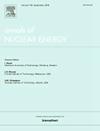Development of mechanistic model for CHF based on boiling crisis process
IF 1.9
3区 工程技术
Q1 NUCLEAR SCIENCE & TECHNOLOGY
引用次数: 0
Abstract
Accurate prediction of critical heat flux (CHF) is significant in the design and operation of boiling heat transfer equipment. In response to this issue, a mechanistic CHF model, also called the double-wave model, is proposed based on detailed experimental visualization. Based on energy conservation at wave trough, a new mechanistic model is solved through a mechanistic modeling approach. The prediction results of the mechanistic CHF model are in good agreement with the experimental results, with mean error (ME), mean absolute error (MAE), and root mean square error (RMSE) of 11.7%, 15.8%, and 18.4%, respectively. In addition, the double-wave model has a good predictive ability on the results of different researchers. The relevant research in this paper provides an important foundation for safety assessment of thermal systems and boiling heat transfer enhancement.
求助全文
约1分钟内获得全文
求助全文
来源期刊

Annals of Nuclear Energy
工程技术-核科学技术
CiteScore
4.30
自引率
21.10%
发文量
632
审稿时长
7.3 months
期刊介绍:
Annals of Nuclear Energy provides an international medium for the communication of original research, ideas and developments in all areas of the field of nuclear energy science and technology. Its scope embraces nuclear fuel reserves, fuel cycles and cost, materials, processing, system and component technology (fission only), design and optimization, direct conversion of nuclear energy sources, environmental control, reactor physics, heat transfer and fluid dynamics, structural analysis, fuel management, future developments, nuclear fuel and safety, nuclear aerosol, neutron physics, computer technology (both software and hardware), risk assessment, radioactive waste disposal and reactor thermal hydraulics. Papers submitted to Annals need to demonstrate a clear link to nuclear power generation/nuclear engineering. Papers which deal with pure nuclear physics, pure health physics, imaging, or attenuation and shielding properties of concretes and various geological materials are not within the scope of the journal. Also, papers that deal with policy or economics are not within the scope of the journal.
 求助内容:
求助内容: 应助结果提醒方式:
应助结果提醒方式:


